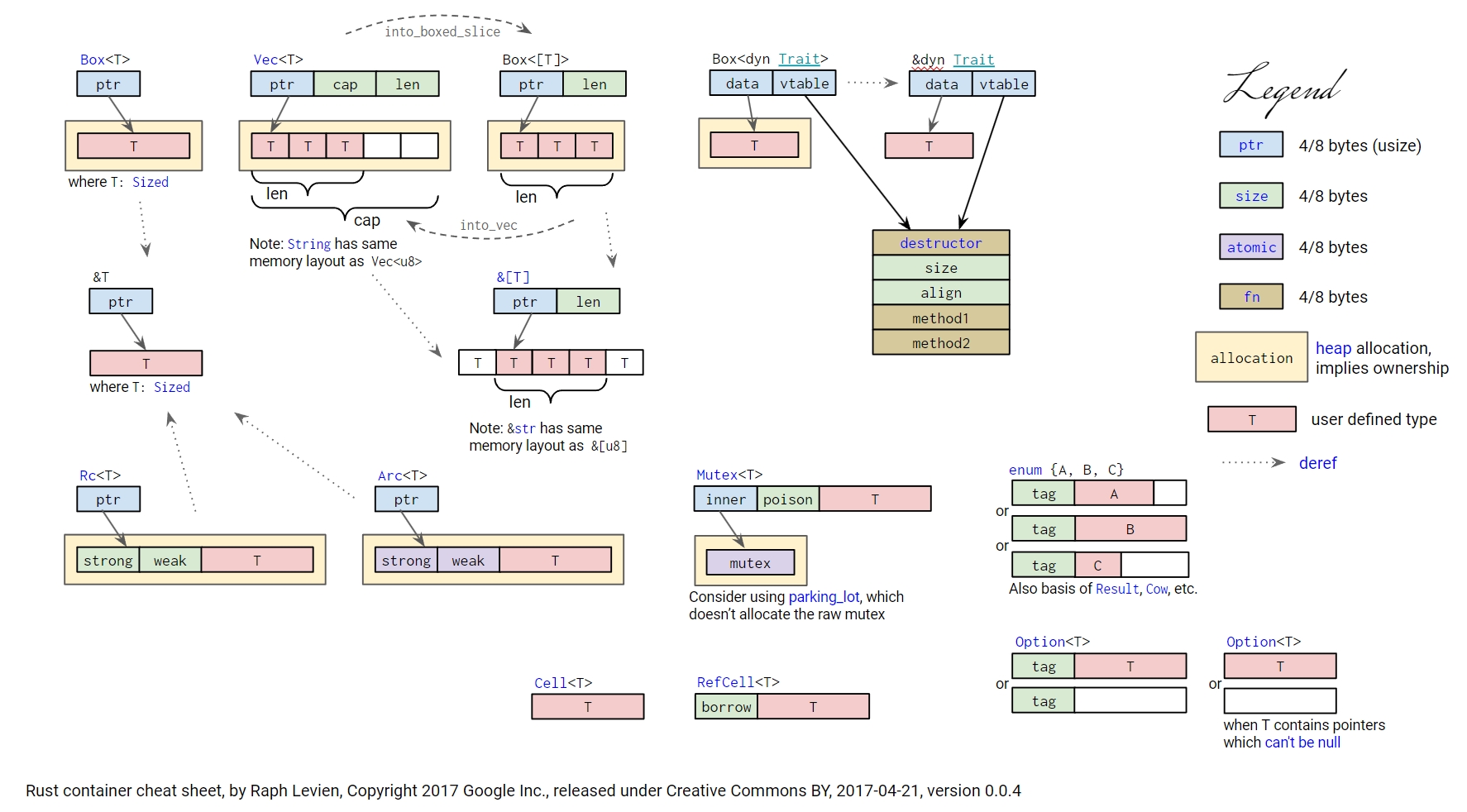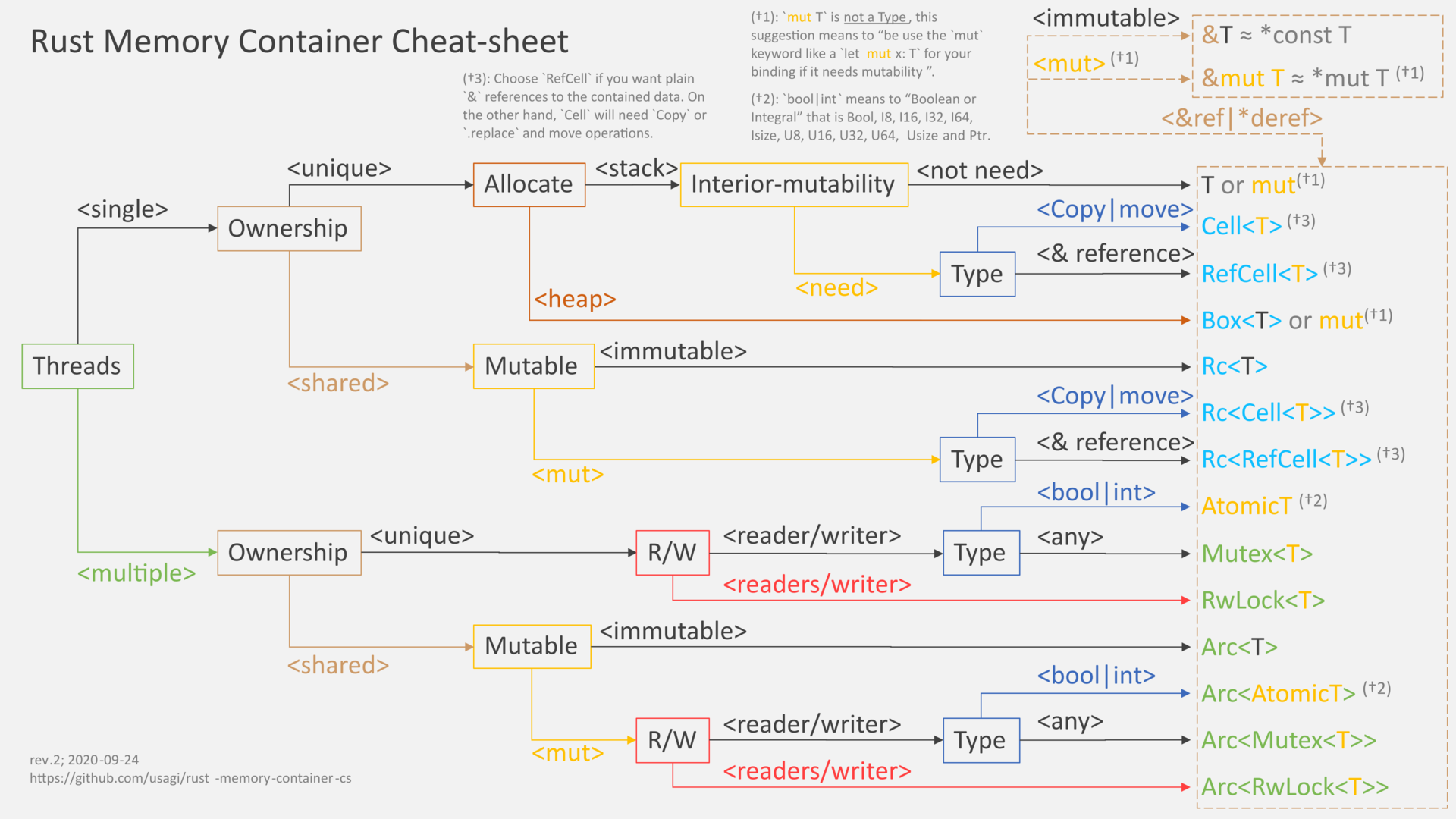Rust Memory Container Cheat Sheet and the Rust Container Cheat Sheet. These visual aids provide concise and clear representations of Rust's memory containers, aiding in understanding their structures and relationships.
Rust Memory Container Cheat Sheet

Image Source: Rust Memory Container Cheat Sheet by Usagi Ito
This cheat sheet, created by Usagi Ito, offers a comprehensive overview of Rust's memory containers, illustrating their layouts and how they manage memory. It's an excellent reference for both beginners and seasoned Rustaceans aiming to deepen their understanding of Rust's memory management.
For more details and additional formats, visit the GitHub repository.
Rust Container Cheat Sheet

Image Source: Rust Container Cheat Sheet by Raph Levien
This cheat sheet, designed by Raph Levien, provides a detailed look at Rust's container types, their memory layouts, and associated methods. It's a handy tool for developers seeking to grasp the nuances of Rust's standard library containers.
You can download the PDF version here.
Note: All credit for these cheat sheets goes to their respective authors. Please refer to the original sources for the most up-to-date versions and additional information.
Rust Memory Container Types
Rust's standard library offers a variety of memory container types, each designed for specific use cases. Here are some commonly used containers:
-
Vectors (
Vec<T>): A dynamic array that can grow or shrink in size. Documentation. -
Strings (
String): A growable, mutable, UTF-8 encoded string. Documentation. -
Hash Maps (
HashMap<K, V>): A hash map implemented with quadratic probing and SIMD lookup. Documentation. -
B-Trees (
BTreeMap<K, V>): An ordered map based on a B-Tree. Documentation. -
Hash Sets (
HashSet<T>): A hash set implemented as aHashMapwhere the value is(). Documentation. -
B-Tree Sets (
BTreeSet<T>): An ordered set based on a B-Tree. Documentation. -
Linked Lists (
LinkedList<T>): A doubly-linked list. Documentation. -
Vec Deques (
VecDeque<T>): A double-ended queue implemented with a growable ring buffer. Documentation. -
Binary Heaps (
BinaryHeap<T>): A priority queue implemented with a binary heap. Documentation. -
Reference Counting (
Rc<T>): A single-threaded reference-counting pointer. Documentation. -
Atomic Reference Counting (
Arc<T>): A thread-safe reference-counting pointer. Documentation. -
Boxes (
Box<T>): A pointer type for heap allocation. Documentation. -
Cells (
Cell<T>): A mutable memory location with 'interior mutability'. Documentation. -
RefCells (
RefCell<T>): A single-threaded mutable memory location with dynamic borrow checking. Documentation. -
Mutexes (
Mutex<T>): A mutual exclusion primitive useful for protecting shared data. Documentation. -
Read-Write Locks (
RwLock<T>): A reader-writer lock allowing multiple readers or one writer. Documentation.
Identifying Performance Issues from Unnecessary Clones
Unnecessary clone operations can lead to performance degradation due to redundant memory allocations. To detect and address these issues:
-
Profiling Tools:
-
cargo flamegraph: Generates flamegraphs to visualize CPU usage, helping identify performance bottlenecks, including excessive cloning. GitHub Repository. -
perf: A powerful performance analyzing tool on Linux that can profile Rust applications to detect inefficient code paths. Rust Performance Book - Profiling.
-
-
Static Analysis:
cargo clippy: A linter that provides warnings about common mistakes, including unnecessary clones. Runningcargo clippycan highlight instances where cloning is avoidable. Rust Design Patterns - Clone to Satisfy the Borrow Checker.
-
Code Review:
- Manual Inspection: Review your codebase to identify
clonecalls. Assess whether ownership transfer or borrowing (&Tor&mut T) is more appropriate.
- Manual Inspection: Review your codebase to identify
-
Benchmarking:
criterion.rs: A benchmarking tool to measure and compare the performance of Rust code, useful for assessing the impact of removing unnecessary clones. Criterion.rs.
By utilizing these tools and practices, you can effectively identify and mitigate performance issues arising from unnecessary cloning in your Rust applications.